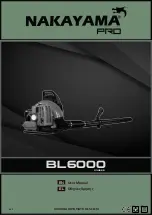
7
Adjust the snow discharge chute to avoid hitting the operator,
bystanders, windows, and other objects with ejected snow. Stay clear
of the snow discharge chute while the engine is running.
Children and pets must be kept away from the area of operation to
avoid injury from flying debris and contact with the snow blower.
Refuel with Care
Gasoline is extremely flammable, and gasoline vapor can explode.
Allow the engine to cool if the snow blower has been in operation.
Refuel only outdoors in a well-ventilated area with the engine OFF. Do
not overfill the fuel tank. Never smoke near gasoline, and keep other
flames and sparks away. Always store gasoline in an approved
container. Make sure that any spilled fuel has been wiped up before
starting the engine.
Turn Engine OFF When Not Operating the Snow
Blower
If you need to leave the snow blower for any reason, even just to
inspect the area ahead, always turn the engine off.
Operation on Slopes
Do not use the snow blower on a slope greater than 20 degrees.
To avoid overturning, be careful when changing the direction of the
snow blower while operating it on a slope. Do not use the snow blower
to remove snow from angled roof tops. The snow blower may overturn
on steep slopes if left unattended, causing injury to the operator or
bystanders.
Operating Conditions
Do not use the snow blower when visibility is poor. Under conditions
of poor visibility, there is a greater risk of striking an obstacle or
causing injury. Adjust the snow discharge chute to avoid hitting
bystanders or vehicles.
Stay clear of the snow discharge chute while the engine is running
and be aware that loose clothing can get drawn into the moving parts.
Operating Near Roads
Always watch for vehicle traffic when operating the snow blower near
roads and driveways.
Operator Responsibility
Know how to stop the snow blower quickly in case of emergency.
Understand the use of all snow blower controls.
Never permit anyone to operate the snow blower without proper
instruction. Do not let children operate the snow blower. If people or
pets suddenly appear in front of the snow blower while it is in
operation, immediately release the auger and drive clutch levers to
stop the snow blower and avoid possible injury from rotating auger
blades.
While operating the snow blower, hold the handle firmly and walk,
don’t run. Wear suitable winter boots that resist slipping.
Wear safety glasses or eye shields during operation to protect eyes
from thrown objects.
Exercise caution on slippery surfaces to avoid falling, especially when
operating in reverse.
Operating the Controls
Engine Switch
The engine switch controls the
ignition system. The key can only be
inserted and removed when turned
to the OFF position.
Recoil-starter Models
OFF – Stops the engine.
ON – Running position, and for
starting with the recoil starter.
Electric-starter Models
OFF – Stops the engine.
ON – Running position, and for
starting with the recoil starter.
START - Use this position to start the
engine with the DC electric starter.
The switch returns to the ON position
when you let go of the key.
Fuel Valve Lever
The fuel valve opens and closes the
fuel line leading from the fuel tank to
the carburetor. Make sure that the
fuel valve lever is positioned exactly
at either the ON or OFF position.
When the snow blower is not in use,
always leave the fuel valve lever in
the OFF position to reduce the
possibility of fuel leakage.
Starter Grip
Pull the starter grip to start the
engine. See
page 10
for detailed
starting procedures.
Throttle/Choke Lever
The throttle/choke lever
controls engine speed from
SLOW to FAST to CHOKE,
and it will stay in any
designated position.
NOTE:
For best snow
blowing performance,
keep the
throttle/choke lever in
the FAST position.
The CHOKE position
is only used when
starting a cold engine.
RECOIL ENGINE SWITCH
ON
OFF
DC ELECTRIC
ENGINE SWITCH
ON
OFF
START
ON
OFF
FUEL VALVE LEVER
STARTER GRIP
SLOW
FAST
FAST
SLOW
THROTTLE/CHOKE
LEVER
SLOW
CHOKE
FAST
CHOKE








































